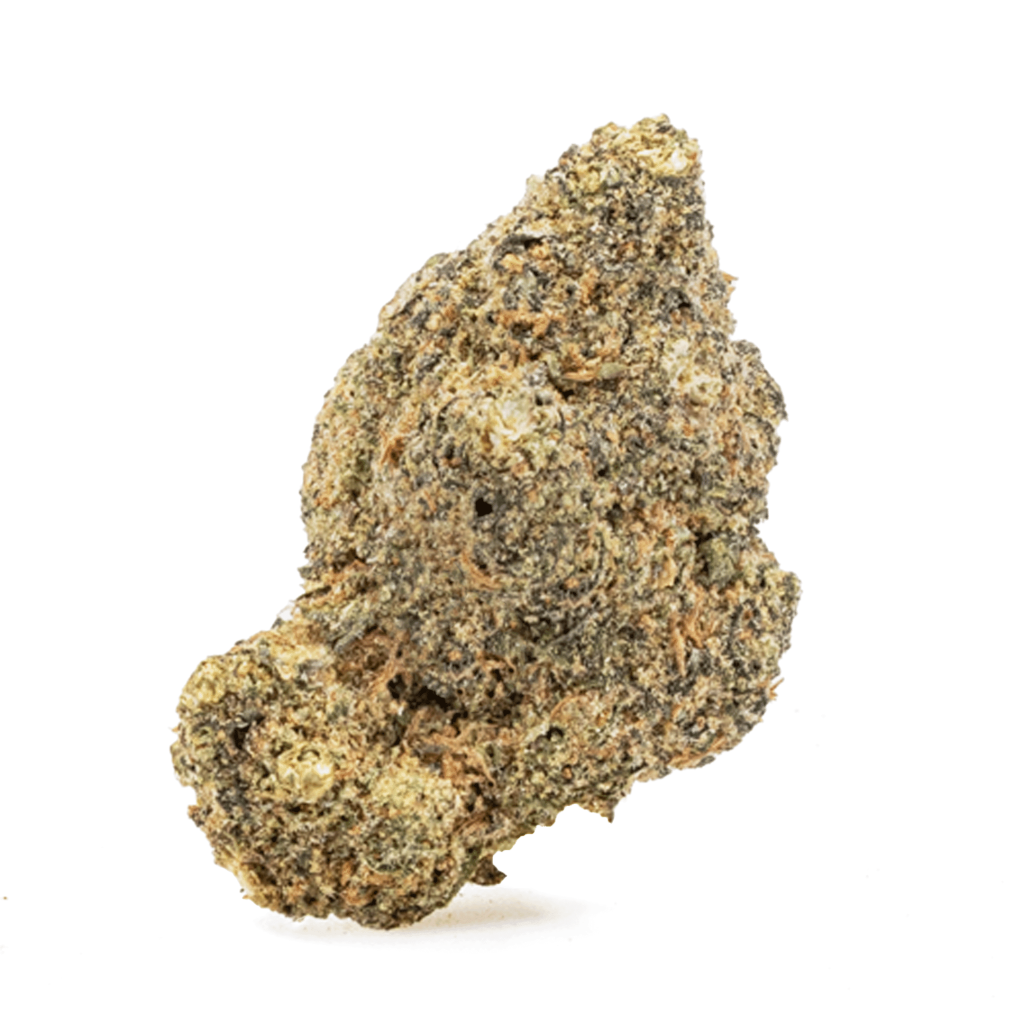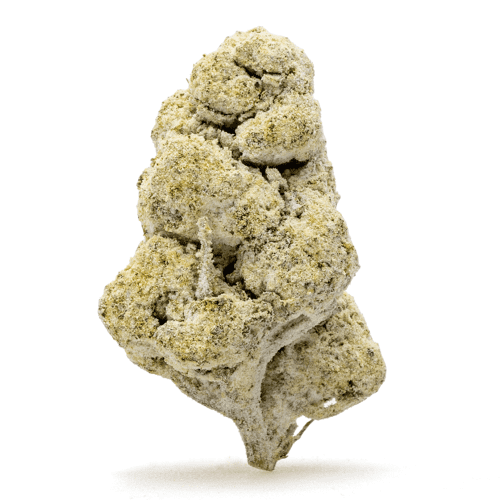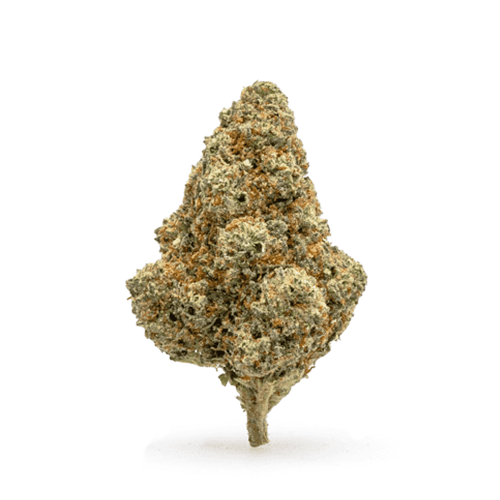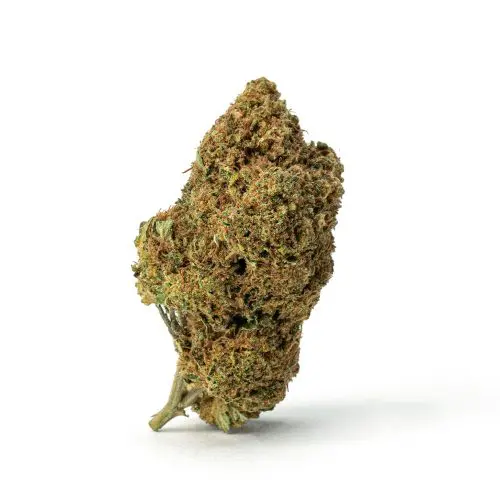Description
Description:
Let the calm flow through you with THCa Flower Baby Yoda, a Sativa-dominant strain known for its earthy sweetness and deeply grounding effects. Each inhale delivers warm notes of pine, fresh herbs, and a touch of citrus, while the exhale lingers with a soft, woody finish that soothes the senses.
The terpene profile is rich in Myrcene, Caryophyllene, and Pinene, a trio that promotes full-body relaxation and gentle mental ease. With dense, olive-green buds coated in glistening trichomes, Baby Yoda is often chosen for quiet evenings, reflective moments, or winding down after a long day.
To unlock its effects, heat is essential – once decarboxylated (typically through smoking or vaporizing), the THCa in Baby Yoda transforms into Delta 9 THC, offering a deeply calming, euphoric experience that’s as peaceful as a galaxy far, far away.
Benefits:
Baby Yoda has become a go-to strain for those seeking calm, clarity, and a subtle cerebral lift. With its roots in Khalifa Kush and The Menthol, this hybrid is reported to deliver a unique combination of tingling body relaxation and focused mental energy. Its terpene profile—dominated by Myrcene and Caryophyllene – contributes to its distinct diesel-sweet aroma and soothing effects. Consumers often reach for Baby Yoda when they need grounding without feeling heavy or disconnected. Reported benefits include:
- Relief from stress and anxious thoughts
- Enhanced focus without overstimulation
- Mild, body-tingling relaxation
- Uplifted mood and emotional clarity
- Reduced symptoms of depression
- A calming sense of presence and balance
Cannabinoid Profile:
| THCa | 27.38% |
| Delta 9 THC | 0.21% |
| Total Cannabinoids | 27.59% |
Learn more…
What is THCa?
THCa is a non-intoxicating cannabinoid produced in raw cannabis before it becomes Delta 9 THC. On its own, it doesn’t cause that iconic euphoric feeling associated with cannabis, so consuming flower without heat won’t deliver any psychoactive effects. However, once heated – by smoking or vaporizing – THCa decarboxylates into active THC. Like other major cannabinoids, THCa has shown potential benefits, including anti-nausea, anti-anxiety, appetite-stimulating, pain-relieving, and neuroprotective properties.
What is THCa flower?
THCa flower offers a wide range of experiences depending on its terpene composition and strain type. From uplifting Sativas to mellow Indicas, each variety produces different mood states once heated. Terpenes like Ocimene and Myrcene play a major role – some consumers report feeling relaxed and euphoric, while others describe a more sociable, talkative effect. Popular choices include Amnesia Haze and Han Solo for their balanced potency and flavor.
To feel the effects, THCa must undergo decarboxylation. Without heat, such as from vaping or smoking, the compound remains non-psychoactive and won’t create any euphoric sensation when consumed raw.
THCa vs THC Flower?
Tetrahydrocannabinolic acid (THCa) is the raw form of THC found in unheated cannabis. Its molecular structure includes an extra carboxyl ring, which blocks it from interacting with the body’s cannabinoid receptors. Once heated, this ring is removed through decarboxylation, converting THCa into Delta 9 THC – the compound responsible for psychoactive effects. Without this process, THCa remains non-intoxicating, which is why raw consumption won’t result in a euphoric experience.
How is THCa flower made?
Unlike many cannabinoid products, THCa flower isn’t processed – it’s simply the raw, unaltered cannabis bud. THCa forms naturally as the plant grows, appearing in the early stages of development. Over time, exposure to sunlight can slowly convert some THCa into Delta 9 THC. However, it’s the application of direct heat – like from a lighter or vaporizer – that fully activates the compound and produces its well-known effects.
What is Sativa?
In 1753, Swedish botanist Carl Linnaeus classified cannabis as Cannabis sativa, noting that these plants were commonly cultivated and grew tall with slender leaves. Sativa strains tend to flourish in warmer climates, thanks to their longer grow cycles and taller plant structure.
Although many associate Sativa strains with energetic or mentally stimulating effects, the reality is more nuanced. How a strain affects someone depends on its full chemical makeup – particularly the balance of cannabinoids and terpenes – as well as the consumer’s unique biology. This explains why the same Sativa may produce very different effects from person to person.
What is Indica?
Jean-Baptiste Lamarck first identified Cannabis indica in 1785 after studying samples from India. He described Indica plants as compact and robust, with wide leaves and a faster growth cycle than Sativa varieties, making them ideal for colder environments.
Although many turn to Indica strains for their reputation of deep physical relaxation and soothing cerebral effects, it’s important to remember that not all Indicas behave the same way. A strain’s impact is influenced by its chemical composition and the physiology of the person using it – not just its classification.
What is an Indica-Sativa Hybrid?
Hybrid strains combine genetics from both Cannabis sativa and Cannabis indica, often in a 50/50 ratio. These plants are selectively bred to merge desired traits – like relaxation from an Indica and mental energy from a Sativa – creating balanced effects that appeal to a wide range of consumers.
Growers frequently document strain genealogy to track how different cultivars are developed. Since not all hybrids are equal, the terms “Sativa-dominant” and “Indica-dominant” help describe the direction of the effects based on which lineage is more prominent.
What is the Difference Between Indica and Sativa Strains?
Indica and Sativa plants differ mainly in their physical traits and growing preferences. Indica’s are compact with wide leaves and thrive in colder environments due to their short grow cycle. Sativas, by contrast, are tall with thin leaves and do best in warmer climates where they have more time to mature.
Although many believe Indicas are always calming and Sativas always uplifting, effects vary from person to person. The real impact depends on a strain’s chemical makeup – not just whether it’s labeled Indica or Sativa. Factors like terpene profile, THC content, and the consumer’s physiology all play a role in how a strain feels.
Which is Stronger Indica or Sativa?
There’s no universal answer to which strain type is stronger; potency varies by strain and person. Indica and Sativa labels don’t determine strength. Instead, it’s the cannabinoids, terpenes, flavonoids, and how your body responds that shape the experience.
As more people explore cannabis, interest in terpene profiles has grown. Compounds like Myrcene and Limonene can influence whether a strain feels more relaxing, energizing, or mood-boosting – making them a better guide than strain type alone.
What is the Baby Yoda Strain?
Baby Yoda is a standout hybrid strain that blends distinctive flavor with deeply soothing effects. A cross between Khalifa Kush and The Menthol, this cultivar is known for its dense, frosty buds and bold aroma – a layered mix of diesel, earth, and subtle sweetness. The striking green flower is threaded with orange pistils and coated in shimmering golden trichomes, hinting at the potency within.
Reported THCa levels often reach the mid-20% range, and the experience is typically described as a body-tingling calm that slowly gives way to mental focus and mellow euphoria. The terpene profile is led by Myrcene and Caryophyllene, with hints of Pinene rounding out the flavor. Baby Yoda is favored by those looking to ease tension, reduce anxiety, or settle in for a stress-free evening. Many say it strikes the perfect balance between physical relaxation and mindful clarity—ideal for when you need to reset without checking out.
What are Terpenes?
Naturally occurring in many plants and a few insects, terpenes are the compounds responsible for the unique aromas of things like pine trees, citrus fruits, and lavender. In nature, their scent may serve to ward off predators or attract pollinators. In cannabis, however, terpenes are gaining attention for their potential therapeutic value – helping to regulate mood, reduce stress, and amplify the benefits of THC and CBD. The most prominent cannabis terpenes include Myrcene, Beta-Caryophyllene, and Alpha-Pinene.
What is Myrcene?
Myrcene has an earthy, fruity, and clove-like aroma. It is found in hops, mango, lemongrass, and thyme. This delicious terpene is found in the Gold Cash strain, Blue Dream strain, and Granddaddy Purple strain.
What are the Benefits of Myrcene?
Many say that Myrcene is extremely relaxing and can make some sleepy. This has helped reduce stress and anxiety. Research has shown Myrcene also helps reduce inflammation while enhancing sleep.
What is Limonene?
Limonene is a terpene known for its vibrant citrus aroma, commonly found in the rinds of citrus fruits and in many cannabis strains. It’s often associated with elevated mood, stress reduction, and anti-inflammatory properties. Because of its sharp, clean scent and potential therapeutic benefits, Limonene is a popular terpene among those seeking a clear-headed or refreshing cannabis experience.
What are the Benefits of Limonene?
Limonene is often associated with a bright, calming effect that many consumers describe as both relaxing and mood-lifting. Some have experienced quick relief from queasiness or digestive discomfort. Studies also indicate that Limonene may have natural anti-inflammatory and antioxidant effects, adding to its therapeutic potential.
What is Caryophyllene?
Caryophyllene is a terpene known for its bold, earthy aroma with notes of black pepper and warm spices. It’s one of the few terpenes that can bind to cannabinoid receptors in the body, specifically CB2, giving it a role in potential anti-inflammatory and analgesic effects. Found in both cannabis and culinary spices, Caryophyllene is often present in strains used for stress or discomfort.
What are the Benefits of Caryophyllene?
The benefits of Caryophyllene go beyond its bold, peppery flavor. This terpene may offer therapeutic effects like reduced inflammation, pain relief, and stress support. Its ability to engage with the body’s endocannabinoid system gives it a unique role in promoting balance and comfort, making it a popular choice in strains aimed at relaxation and recovery.
What are Flavonoids?
Found in fruits, vegetables, herbs, and cannabis, flavonoids are natural compounds with a wide range of roles. They help regulate plant growth and protect against bacteria, fungi, and sun damage. With thousands identified so far, flavonoids also shape how we perceive flavor and scent. In cannabis, they work alongside terpenes and cannabinoids to influence aroma, taste, and even effects, making them a key factor in what sets one strain apart from another.
Where To Buy Baby Yoda THCa Flower Online?
CannaBuddy is proud to offer premium THCa flower, including standout cultivars like Baby Yoda – a strain known for its calming effects and rich, earthy profile. We collaborate with reputable growers and industry leaders to bring you carefully selected, high-potency cannabis products that meet the highest standards in consistency and purity.
From smokable flower to CBD edibles and Delta 9-infused treats, every product we carry is third-party tested for quality and reliability. Once you’ve added Baby Yoda to your stash, don’t forget to browse the rest of our curated cannabis lineup.
Suggested Use:
Consume as needed
Serving Size: 1 puff
Servings per unit: Varies
Ingredients:
100% high-THCa hemp flower containing < 0.3 % Delta 9 THC
Product Lab Results:
THCa Flower Baby Yoda COA
Shop more THCa flowers and Pre-Rolls at CannaBuddy today!







Reviews
There are no reviews yet.